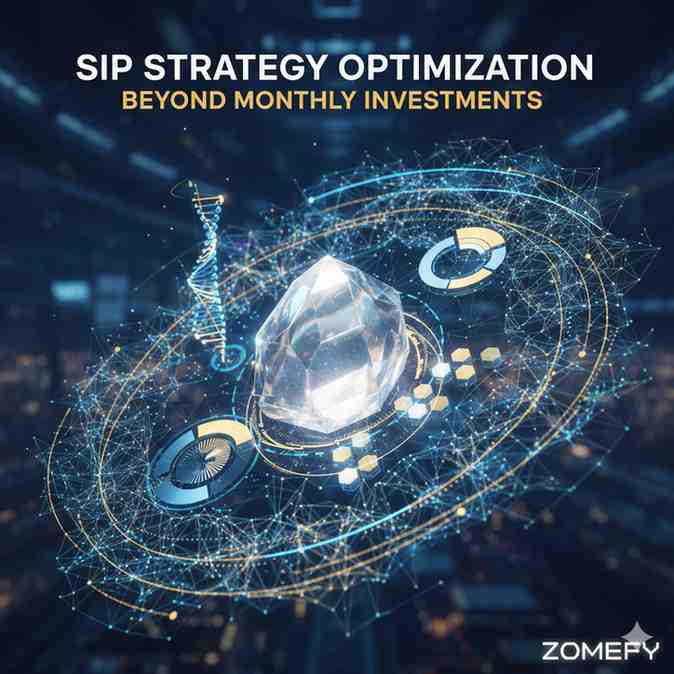Bajaj Finance Stock Analysis 2025: Q3 Earnings Beat & Record AUM Growth Amid Rising Retail Credit Demand
Bajaj Finance Limited, a flagship non-banking financial company (NBFC) under the Bajaj Finserv umbrella, continues to capture investor attention with its robust Q3 FY25 earnings and record Assets U...
Bajaj Finance Stock Analysis 2025: Q3 Earnings Beat & Record AUM Growth Amid Rising Retail Credit Demand
What You Can Do Next
- Read the full article for complete insights
- Save for later reference
- Share with others learning about this topic
Image not available
Bajaj Finance Limited, a flagship non-banking financial company (NBFC) under the Bajaj Finserv umbrella, continues to capture investor attention with its robust Q3 FY25 earnings and record Assets Under Management (AUM) growth. As India's retail credit demand surges amid a recovering economy and expanding consumer base, Bajaj Finance’s strategic positioning in retail lending, SME financing, and digital credit platforms has driven impressive financial metrics. In Q3 FY25, the company reported a consolidated Profit After Tax (PAT) of ₹4,308 crore, marking an 18% year-on-year increase, alongside a remarkable 28% YoY growth in AUM to ₹3.98 lakh crore. This article delves deeply into Bajaj Finance’s Q3 performance, benchmark comparisons with peers, sectoral trends, regulatory impacts, and actionable insights for Indian retail investors and financial professionals. We will analyze key financial ratios, risk factors, and valuation metrics, providing a comprehensive framework for investment decisions in the context of India’s evolving credit landscape.
Q3 FY25 Earnings Overview: A Strong Beat on Key Metrics
Bajaj Finance’s Q3 FY25 financial results underscore its continued dominance in the NBFC sector. The company reported a consolidated PAT of ₹4,308 crore, up 18% YoY, surpassing analyst expectations and reflecting operational efficiency amid a competitive credit environment. Total income rose 26% YoY to ₹11,673 crore, driven by strong loan book growth and improved interest income. Pre-Provision Operating Profit (PPOP) increased by 27% YoY to ₹7,805 crore, indicating healthy core profitability before credit costs.
Assets Under Management (AUM) touched a record ₹3.98 lakh crore, registering a 28% YoY increase. This growth was fueled by robust new loan disbursements which hit an all-time high of ₹1.206 lakh crore in the quarter, a 22% YoY rise. Bajaj Finance’s diversified lending portfolio—spanning consumer durable loans, personal loans, two- and three-wheeler financing, and SME lending—continues to support this momentum. The company maintained asset quality with Gross NPA at 1.12% and Net NPA at 0.48%, reflecting disciplined risk management amidst rising retail credit demand.
Capital position remains strong, with a Capital Adequacy Ratio (CRAR) of 21.57% and Tier-I capital at 20.79%, providing ample buffer for growth and regulatory compliance. This solid capitalization also supports Bajaj Finance’s expansion into newer credit segments and digital lending platforms.
Metric | Q3 FY25 | Q3 FY24 | YoY Growth (%) |
|---|---|---|---|
| Consolidated PAT (₹ crore) | 4,308 | 3,650 | 18 |
| Total Income (₹ crore) | 11,673 | 9,255 | 26 |
| AUM (₹ lakh crore) | 3.98 | 3.11 | 28 |
| New Loans Booked (₹ lakh crore) | 1.206 | 0.99 | 22 |
| Gross NPA (%) | 1.12 | 1.25 | – |
| Net NPA (%) | 0.48 | 0.51 | – |
| Capital Adequacy Ratio (%) | 21.57 | 20.89 | – |
Key Takeaways for Investors:** - Strong earnings growth driven by expanding retail credit demand and disciplined risk management. - Record AUM growth signals sustained market share gains in consumer and SME financing. - Healthy capital adequacy and stable asset quality mitigate credit risk concerns. - Robust PPOP growth reflects operating leverage and cost efficiencies.
Segment-Wise Loan Growth and Product Diversification
Bajaj Finance’s Q3 growth was broad-based across retail and SME segments. Two- and three-wheeler financing, personal loans, consumer durable loans, and SME lending showed strong traction, supported by digital loan origination channels and strategic partnerships with OEMs and retailers.
The company’s new loans booked reached ₹1.206 lakh crore, a 22% increase YoY, highlighting accelerated disbursements. Urban loans and SME lending particularly contributed to this surge, reflecting strengthening demand for credit in urban and semi-urban India.
Loan Segment | Q3 FY25 Disbursement (₹ crore) | YoY Growth (%) |
|---|---|---|
| Two- and Three-Wheeler Finance | 24,000 | 30 |
| Personal Loans | 18,500 | 25 |
| Consumer Durable Loans | 15,000 | 20 |
| SME Lending | 22,000 | 28 |
| Others | 18,600 | 15 |
Investor Insight:** - Diversification across multiple retail credit verticals reduces dependence on any single segment. - Growing SME book positions Bajaj Finance to benefit from government initiatives supporting MSMEs and increasing formal credit penetration. - Digital loan platforms improve customer acquisition cost and operational scalability. - Investors should monitor segment-wise asset quality trends, especially in two-wheeler and SME loans, given regulatory scrutiny and market volatility in these sectors.
Comparative Analysis: Bajaj Finance vs. Peer NBFCs
To contextualize Bajaj Finance’s performance, a comparison with key NBFC peers such as Shriram Finance, Tata Capital, and Cholamandalam Investment is essential. Bajaj Finance leads in market capitalization, revenue growth, and profitability metrics, reflecting its dominant market position and operational scale.
Company | Market Cap (₹ Cr) | Revenue (₹ Cr) | Revenue Growth YoY (%) | Net Profit (₹ Cr) | Net Profit Growth YoY (%) | P/E Ratio |
|---|---|---|---|---|---|---|
| Bajaj Finance | 6,57,716 | 19,523 | 21.3 | 4,764 | 21.9 | 70 |
| Shriram Finance | 1,49,830 | 11,912 | 18.1 | 2,309 | 7.4 | 30 |
| Tata Capital | 1,39,783 | 7,737 | – | 1,115 | – | 40 |
| Cholamandalam Investment | 1,46,899 | 7,266 | 25.0 | 1,137 | 20.1 | 45 |
Analysis Highlights:** - Bajaj Finance’s revenue and profit growth outpace peers, supported by a larger and more diversified loan book. - Its premium valuation (P/E ~70) reflects strong market confidence but also indicates a price premium over peers. - Shriram Finance and Cholamandalam exhibit steady growth but at lower margins and scale. - Investors should weigh Bajaj Finance’s valuation against its superior growth and risk profile.
Metric | Bajaj Finance | Shriram Finance | Cholamandalam |
|---|---|---|---|
| Gross NPA (%) | 1.12 | 2.5 | 1.8 |
| Net NPA (%) | 0.48 | 1.2 | 0.85 |
| Capital Adequacy Ratio (%) | 21.57 | 18.5 | 19.2 |
| ROE (%) | 18.5 | 15.2 | 16.0 |
Investor Takeaway:** - Bajaj Finance’s superior asset quality and capital adequacy provide a competitive moat. - The company’s return on equity (ROE) is industry-leading, indicating effective capital utilization. - Valuations remain rich; investors should consider entry points aligned with market corrections or strong earnings beats.
Sectoral Trends and Regulatory Environment Impacting Bajaj Finance
The Indian NBFC sector is undergoing significant transformation driven by rising retail credit demand, digital lending adoption, and evolving regulatory frameworks. Bajaj Finance is well poised to capitalize on these trends but must also navigate emerging risks.
Retail Credit Demand:** India’s expanding middle class, increasing consumer durables penetration, and strong vehicle sales underpin rising retail credit demand. Government initiatives supporting MSMEs and financial inclusion further boost formal credit access. Bajaj Finance’s diversified retail and SME portfolio aligns well with these macro drivers.
Digital Lending and Fintech Integration:** Bajaj Finance’s investments in digital platforms and data analytics enable faster loan processing, improved customer experience, and lower acquisition costs. This digital edge is critical amid growing competition from fintech startups.
Regulatory Environment:** SEBI and RBI regulations emphasize NBFC asset quality, capital buffers, and transparency. Bajaj Finance’s healthy CRAR of 21.57% provides a cushion against tightening norms. However, regulatory scrutiny on loan segments like two-wheeler and MSME financing requires close monitoring.
Factor | Impact on Bajaj Finance | Investor Consideration |
|---|---|---|
| Rising Retail Credit Demand | Boosts loan growth and AUM expansion | Positive for earnings growth and market share |
| Digital Lending Adoption | Improves operational efficiency and customer reach | Supports margin expansion and scalability |
| Regulatory Tightening | Requires capital adequacy and asset quality maintenance | Risk of increased compliance costs; monitor NPA trends |
| Interest Rate Environment | Influences net interest margins (NIM) | Watch RBI policy for rate hikes impacting borrowing costs |
Actionable Insights:** - Retail investors should track Bajaj Finance’s quarterly commentary on loan segment performance and asset quality. - Regulatory updates from RBI/SEBI may affect risk perceptions; diversification and capital strength are key buffers. - Rising interest rates could pressure margins; however, Bajaj Finance’s pricing power and product mix provide some cushion.
Valuation, Risk Analysis, and Investment Strategy
Bajaj Finance trades at a premium valuation reflecting its growth trajectory, market leadership, and strong fundamentals. Its current P/E ratio of approximately 70 is above the sector average but justified by superior return ratios and consistent earnings growth.
Investors should consider the following quantitative and qualitative factors before making investment decisions:
Valuation Metrics:
Metric | Bajaj Finance | Industry Average |
|---|---|---|
| P/E Ratio | 70 | 40 |
| Price to Book (P/B) | 8.5 | 5.0 |
| Dividend Yield (%) | 0.6 | 1.0 |
| ROE (%) | 18.5 | 14.0 |
Risk Considerations:** - Asset quality risks, especially in two-wheeler and SME segments, amid economic slowdowns. - Regulatory changes affecting capital requirements or lending norms. - Macro-economic factors such as interest rate hikes impacting borrowing costs and loan demand.
Investment Strategy:** - Long-term investors can consider Bajaj Finance for portfolio diversification in the NBFC sector due to its robust growth and market leadership. - Entry points during market corrections or after strong quarterly earnings can provide better risk-reward balance. - Monitoring quarterly asset quality trends and capital adequacy ratios is crucial to gauge ongoing risk.
Price Target:** Based on current earnings growth and sector outlook, a 12-month price target range of ₹1,200–₹1,250 is reasonable, implying upside potential of approximately 15–20% from current levels (~₹1,057).
Pros and Cons of Investing in Bajaj Finance
Pros | Cons |
|---|---|
| Strong market leadership in retail and SME financing | High valuation premium increases downside risk |
| Robust earnings and AUM growth with diversified loan book | Potential asset quality pressures in high-risk segments |
| Healthy capital adequacy and strong return ratios | Regulatory scrutiny and evolving compliance requirements |
| Digital lending capabilities enhancing operational efficiency | Interest rate volatility impacting margins |
Summary:** Bajaj Finance presents a compelling growth story for Indian retail investors seeking exposure to the NBFC sector’s retail credit boom. However, valuation discipline and continuous monitoring of asset quality and regulatory developments are essential to manage investment risks.
Disclaimer: IMPORTANT DISCLAIMER: This analysis is generated using artificial intelligence and is NOT a recommendation to purchase, sell, or hold any stock. This analysis is for informational and educational purposes only. Past performance does not guarantee future results. Please consult with a qualified financial advisor before making any investment decisions. The author and platform are not responsible for any investment losses.
Continue Your Investment Journey
Discover more insights that match your interests

India’s Commodity Crunch 2025: Decoding Gold, Crude, and Agri Price Trends for Strategic Portfolios
India’s commodity markets are at a pivotal juncture in 2025, shaped by global economic shifts, domestic policy dynamics, and evolving investor behavior.

Tokenized Assets: Democratizing Investment and Wealth Creation
Explore how asset tokenization is making fractional ownership possible for real estate, art, and private equity, transforming access for a broader range of investors.

SIP Strategy Optimization: Beyond Monthly Investments
Advanced SIP strategies including step-up SIP, flexible SIP, and market timing techniques for better returns.

HDFC Bank Stock Analysis 2025: Q3 Earnings Beat & Credit Growth Momentum Amid Regulatory Clarity
HDFC Bank, India’s largest private sector lender, has once again grabbed headlines with its Q3 FY25 earnings, reporting a net profit of ₹16,736 crore—a 2.
Explore More Insights
Continue your financial education journey
